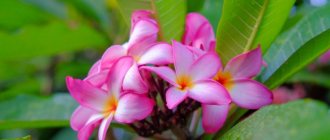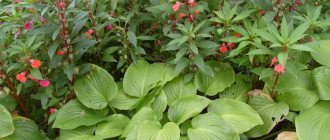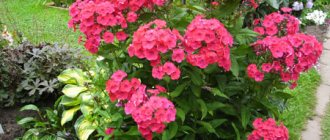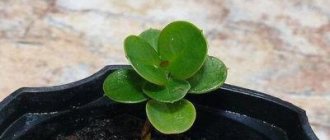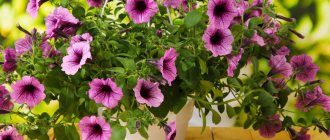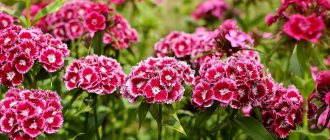What you need to know about Brugmansia
Brugmansia is a heat-loving flower that can be grown both in containers and in open ground. The plant is represented by small trees and shrubs. Some varieties can reach 5 meters in height.
The flower does not like drafts or lack of light. Needs replanting, fertilizing and timely pruning. The first pruning is carried out in the second year of the plant’s life - dry branches are removed and new ones are shortened.
Brugmansia is sown from January to March, and it blooms from July to December.
Reproduction methods
Brugmansia reproduces in 3 ways:
- Seeds;
- Cuttings;
- By layering.
Seeds
Brugmansia from seeds at home begins to be grown in early January. Brugmansia can be planted until mid-March. The seeds are planted shallowly in the ground, approximately 0.5-1 cm. After they are sprinkled with soil, it is recommended to moisten the soil well and make a kind of greenhouse by covering the planting area with film.
Note! Shoots can appear either 2 weeks after planting or 2.5 months
Cuttings
There are 2 types of cuttings from a shrub or tree:
- Stem;
- Root.
It is allowed to propagate Brugmansia from cuttings if it is at least a year old. This procedure can be carried out 2 times a year: in early autumn and early spring. Most gardeners prefer to take cuttings from a plant in the spring, believing that during this period the root system develops faster. What time should I plant Brugmansia in the spring? You can start doing this from mid-March. This method is easier than the previous one. In addition, a shrub or tree propagated by cuttings develops faster and, accordingly, blooms faster.
To prepare cuttings, you should choose stems that are at least 25 cm long. The stem is cut with pruning shears, from its upper part, under the apical branch. As in most cases of plant propagation by cuttings, the lower leaves are completely removed, and the upper leaves are cut in half.
Important! Cuttings are cut from a tree whose height is at least 85 cm. This is explained by the high bud formation
Root cuttings of Brugmansia are the more preferable method for beginners, since the shrub that has grown after using this method takes root better, develops faster, and is easier to care for.
Rooting Brugmansia in the substrate
Rooting of cuttings is carried out either in water or in a special soil mixture.
Note! Rooting cuttings in water is not suitable for all varieties of Brugmansia
By layering
This is the most labor-intensive method of propagating Brugmansia. In order to obtain layering, it is necessary to select a well-developed shoot on an adult plant and make a shallow cut in the bud. Next, a root growth stimulator is poured into it, and the entire incision site is wrapped in moss. Purchase special moss, for example, sphagnum
It is very important to constantly moisturize the incision site. This procedure is carried out in mid-March; already in mid-June, the resulting cuttings can be cut and planted in a nutrient substrate for 14-21 days
After the shoot has begun to grow, it can be transplanted to a permanent habitat.
Heat-loving Brugmansia
Brugmansia flowers are not too capricious to maintain, but if basic care rules are not followed, the shrub may die. By placing the plant in a warm and bright place, regularly fertilizing the soil with nutrients, maintaining a certain air humidity and making timely pruning, you can enjoy long and lush flowering and the exquisite aroma of this exotic flower.
Seed preparation
The germination rate of Brugmansia seeds is 70-80%, so it is important to prepare them for sowing to increase the chances of getting more beautiful plants.
Preparation takes place in 3 stages:
- Disinfection - keep the seeds for half an hour in a solution of Fitosporin (can be replaced with potassium permanganate).
- Soaking - to speed up germination, seed material is dipped in Epin solution.
- Breaking the shell - using any sharp object, cut the seed shell to make it easier for the sprout to release.
Container for germination and picking
The easiest way to sprout is in a regular food container. What are its advantages: easy to find and purchase, has a transparent lid, easy to deform according to the needs of the plant.
The conditions for germination are greenhouse conditions - that is, warmth, moisture and additional lighting.
Equip the bottom and lid with several holes (small) so that excess moisture escapes and air circulates.
For picking, you also don’t have to reinvent the wheel - ordinary plastic glasses will help out.
Soil preparation
It is not necessary to prepare the soil for sowing seeds with your own hands. In the case of Brugmansia, a ready-made commercial substrate for indoor flowers is quite suitable for you. The plant loves loose soil, so add perlite or sand. You can also improve its quality with humus.
The finished mixture is disinfected with Fitosporin solution.
The soil requirements of mature plants are slightly different. The mixture for them (for the purpose of transplanting into a larger pot) is prepared from peat, sand and clay. In open ground, Brugmansia prefers loam.
Ode to beauty
Its 30-centimeter bell flowers are amazing! It’s not for nothing that they are also called “angel trumpets” - if angels in heaven really announce their good deeds by playing trumpets, then these musical instruments should look exactly like this.
The Brugmansia bush grows large, up to 3-4 m, so you need to take care of its location in advance. Such an exquisite beauty should have enough light, warmth, protection from drafts and possible mechanical damage to its fragile, beautiful inflorescences.
And of course it would be a crime to shove a tub of Brugmansia into the far corner of the room! After all, when its stunning flowers bloom, it willy-nilly outshine all other objects in the room, becoming the main decoration and an unsurpassed element of decor.
And nature has worked with special diligence on the colors of Brugmansias: from the most delicate shades of peach, cream, pink to radical acid colors, as well as two-, three- and even four-color colors, simple and terry.
And what an exquisitely delicate and at the same time strong aroma these bell flowers have! It fills the air around itself with the finest waves of aphrodesiac, lifts the mood, evokes desires... How to grow such a wonderful plant?
Sowing Brugmansia seeds
Sowing consists of five simple steps:
- The substrate is lightly watered so that it is moist, but at the same time loose.
- The seeds are carefully distributed over the surface at a distance of 3 cm from each other and pressed down slightly. Next they need to be sprinkled with a small ball of soil (0.5 cm).
- The container with the seeds is sent to a bright and warm (22-25°C) place. Seedlings need ten hours of daylight, so take care of lamps or other sources of additional lighting.
- The container is opened slightly several times a day. Condensation can be observed on the lid at this time. It must be removed with a clean napkin.
- From time to time the soil needs to be watered.
Brugmansia loves moisture, so spray the hatched seedlings with water using a spray bottle. They will appear at different times. You will see the first ones in two weeks, the rest will take several months.
Description
The Brugmansia flower acquired the name “intoxicating tree” due to the presence of a strongly odorous substance in different parts.
The name “angel trumpets” is associated with the shape of the flowers, which look like small gramophones and bells. It grows in the form of a bush or small tree, very fond of warmth. Under natural conditions, this is a fairly tall plant, at home the height is up to 2 meters. The shoots grow actively in spring and summer, but become woody slowly. To form a beautiful crown, they must be removed regularly.
Leaves with cuttings, smooth edges, with fluff on the surface. The root system develops quickly, forming a clump close to the surface, while at the same time sending several long roots into the depths.
This ornamental bush gained popularity thanks to its beautiful, relatively large flowers (length up to 25 cm, diameter up to 15 cm). They are fragrant, the smell is more intense in the evening.
The color depends on the variety; flowering is wavy and begins after the above-ground part has fully formed. The Brugmansia fruit resembles a gray hot pepper (see photo) with a length of up to 12 cm, the seeds are in the form of small “cakes” with a diameter of 1 cm.
Varieties
Popular varieties:
- fragrant (fragrant) - imported from Brazil, blooms indoors under favorable conditions all year round, flowers are white (sometimes light green);
- golden - long leaves (up to 50 cm), yellow-orange flowers;
- snow-white (woody) – white flowers;
- bloody - flowers are bright, red, orange, less often yellow, tolerates frost well;
- multi-colored - the young bush has white flowers, with age the color changes to orange, peach, length up to 50 cm.
When grown in the garden, buds of all varieties form late. In the spring, indoor plants can be taken outside without fear that they will freeze.
Picking and transshipment
A couple of months after pipping, when the sprout has five leaves, it is dived into a separate glass. Two weeks after this procedure, the seedlings need to be fed for the first time in their lives. Use half the dose of nitrogen fertilizer.
Transshipment into open ground is carried out when frosts disappear and there is a stable warm temperature. In different regions this happens at different times. In the northern ones - in June, in the southern ones - in May.
In the Becker online store you will find a large assortment of flower seeds.
You can buy seeds of biennial flowers, seeds of annual flowers, perennials and houseplants. Author: Natalya Palamarchuk
Possible difficulties in growing
During the growing period of the plant, you may encounter some difficulties. With improper irrigation, leaves begin to fall. To eliminate the problem, regular proper watering is required, taking into account the temperature regime.
With a lack of light, the shoots become thin and stretched, and the foliage turns pale. The plant must be moved to a windowsill with plenty of sunlight. If necessary, you will need to supplement the lighting with a lamp. If the amount of fertilizer is insufficient, plant growth will slow down.
The bush may lose young buds if there is no moisture, sudden temperature changes occur, or there is not enough sunlight. To eliminate the problem, you need to provide the flower with sufficient lighting and adjust the watering regime.




